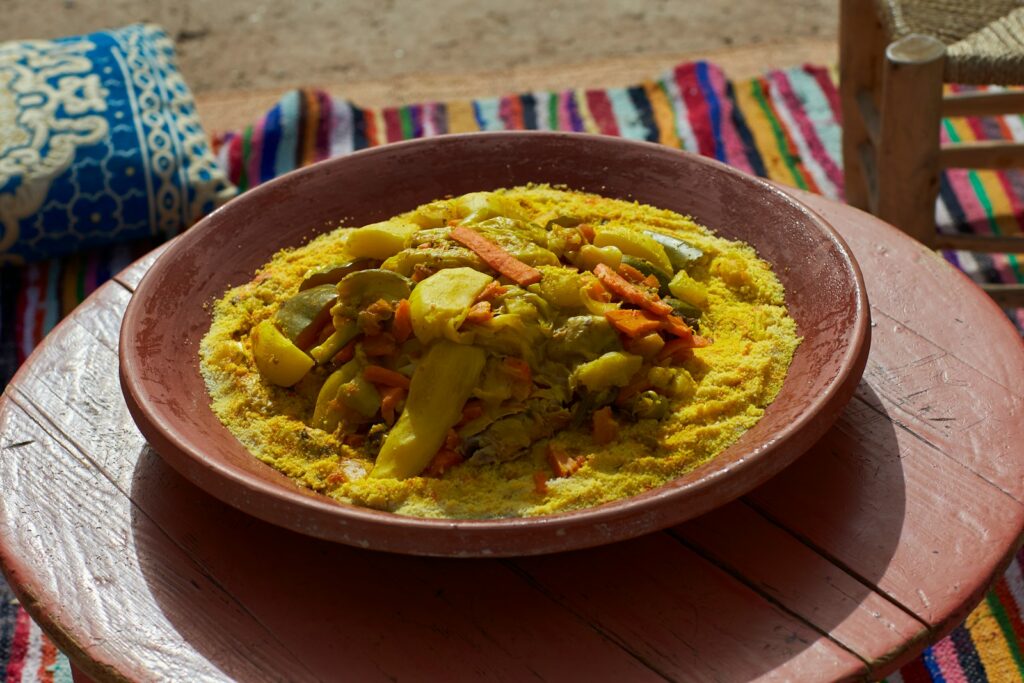Moroccan food is more than just a meal; it is a warm, sensory embrace. From the bustling markets of Marrakech to the quiet kitchens of a mountain Riad, the food is the true heart of Morocco. This guide will take you on a culinary journey, helping you understand the key dishes, the foundational flavors, and how to eat like a local. Forget simply trying the food—we are diving deep into the secrets that make Moroccan Cuisine one of the greatest in the world. Get ready to explore Tagine, savor Couscous, and sample the best street food the country has to offer!
Understanding the Fundamentals of Moroccan Cuisine
To truly appreciate any dish in Morocco, you first need to understand the building blocks: the spices that form the soul of the cooking, and the famous mint tea that acts as the universal social glue. These elements are non-negotiable and define the flavor profile and social experience of Moroccan Cuisine.
The Spice Rack: Core Flavors of Authentic Moroccan Cuisine
The depth and complexity of Moroccan food come from its strategic use of spices, which reflects centuries of trade across the Sahara and the Mediterranean. This is not about heat; it is about aroma and layering. Every cook has their own blend, but the common thread is always a warm, earthy base.
The most critical foundation spices are turmeric and saffron for color and warmth, and ginger and cumin for an earthy, savory base. You will notice that many dishes start with a combination of all four. Turmeric is used generously, giving many sauces (or marqas) their rich yellow hue, while true saffron, often sourced from Taliouine, is prized for its powerful aroma and color, even though it is used sparingly due to its cost.
The ultimate blend is Ras el Hanout, which translates literally to “head of the shop” or “top shelf.” This is not a single recipe but a signature blend crafted by the spice merchant, often containing anywhere from 10 to over 30 individual ingredients. It usually includes exotic additions like dried lavender, rosebuds, or cubeb pepper, giving it an intensely fragrant and slightly sweet profile. Asking a merchant about their Ras el Hanout blend is a wonderful way to connect with the local culture and gain a true appreciation for Moroccan Cuisine.
| Spice | Flavor Profile | Common Use in Moroccan Cuisine | Tip for Travelers |
|---|---|---|---|
| Cumin | Earthy, warm, slightly bitter | Essential in every Tagine, used heavily on grilled meats and kebabs. | Buy small amounts of fresh, whole cumin seeds in the market; their aroma is unmatched. |
| Saffron | Floral, honey-like, metallic | Used in celebration dishes and Chicken Tagines to add signature color and depth. | If buying saffron, insist on seeing the full threads, not ground powder, to ensure authenticity. |
| Ginger | Pungent, fresh, spicy | Used primarily in dry powder form to add warmth and sharpness to beef and lamb dishes. | Don’t confuse it with the fresh ginger paste common in Asian cooking; the Moroccan version is dried. |
| Ras el Hanout | Complex, floral, aromatic | Used for special recipes, including slow-cooked stews and some pastry fillings. | Use it sparingly! A little goes a very long way in elevating any dish. |
The Art of Hospitality: Why Mint Tea is Essential to Moroccan Cuisine
In Morocco, serving mint tea, or Atay, is not merely offering a beverage; it is a high-level act of hospitality, a sign of welcome, and a non-negotiable social ritual. If you are invited into a home, shop, or Riad, you will be offered tea—and it is considered impolite to refuse.
The drink itself is a strong green tea base, typically Chinese gunpowder tea, that is heavily sweetened and brewed with large bunches of fresh spearmint. The tea is often brewed multiple times and poured with great fanfare from a beautiful, long-spouted silver teapot. The high pour is not for show; it is a technique used to aerate the tea, creating a small, foamy head on the surface of the glass, which is desirable. The three-glass rule is common: the first glass is said to be as strong as life, the second as sweet as love, and the third as gentle as death.
Travel Tip: When you are served tea, do not try to pour your own, and never refill your own glass—this is always the responsibility of the host. If you are invited to watch the preparation, pay attention to how much sugar is used; it is almost always more than you expect! This sweet ritual perfectly embodies the warmth and generosity that are fundamental to the experience of Moroccan Cuisine.
The National Dish: Mastering the Moroccan Tagine
A Tagine is perhaps the most iconic symbol of Moroccan Cuisine. It’s more than just a dish; it’s an entire cooking method, a shared cultural experience, and often the centerpiece of a Moroccan meal. The magic of a tagine lies in the unique clay pot it’s cooked in—a heavy, shallow base topped with a tall, conical lid. This design is crucial because as the food cooks slowly over low heat, the steam rises into the cone, condenses, and drips back down onto the ingredients. This process ensures the meat and vegetables remain incredibly moist, and the flavors are constantly recycled and concentrated into a rich, flavorful sauce called marqa.
What Exactly is a Tagine? (Beyond the Clay Pot)
The word “tagine” refers both to the cooking vessel and the food prepared within it. Traditional tagines are made of unglazed earthenware, which imparts a subtle, earthy flavor to the dish over time. They are designed to cook over hot coals or a slow fire, a technique that requires patience but yields unbeatable tenderness. The key to a great tagine is low and slow cooking. Chefs will often layer the aromatics (onions, garlic, preserved lemons) on the bottom to prevent sticking, then place the meat or poultry, and finally top it with vegetables and a generous sprinkle of spices. When served, the tagine is typically placed right on the table, still hot, its conical lid lifted to release a plume of fragrant steam—a truly theatrical introduction to your meal of authentic Moroccan Cuisine.
The Savory Staples: Must-Try Meat Tagine Varieties
When exploring the world of the Tagine, the savory versions are where you should start. The most popular choice is the Chicken Tagine with Preserved Lemon and Olives. This classic dish perfectly balances the salty, tart kick of preserved lemons (another Moroccan staple) with the buttery richness of marinated chicken and the sharp brine of local olives. The sauce is thin, bright, and highly addictive, meant to be soaked up with fresh bread. Another essential savory option is the Lamb or Beef Tagine with Spices and Herbs. Unlike the chicken version, these often have darker, richer sauces based on caramelized onions, prunes, and a heavy dose of cumin and paprika, slow-cooked until the meat simply falls off the bone. Look for versions that incorporate fresh coriander and parsley, adding a vibrant green freshness to the deep, meaty base.
H3: The Sweet and Savory Balance: Tagine with Prunes and Apricots
One of the characteristics that sets Moroccan Cuisine apart is its brilliant use of sweet and savory elements in the same dish, and the tagine with prunes is the ultimate example. This is typically made with lamb or beef, where the meat is first slow-simmered in a traditional sauce of onions, ginger, and saffron. In the final stages, plump dried prunes and occasionally dried apricots are added, often along with a drizzle of honey and a dusting of cinnamon. The fruits soften and swell, their sweetness creating an incredible caramelized glaze that complements the rich, savory meat. It’s often topped with toasted sesame seeds or fried almonds just before serving, providing a satisfying crunch. This complex interplay of flavors creates a memorable dish that you will often find served at weddings and celebrations.
Simple and Fresh: Seasonal Vegetable Tagine
For vegetarians or anyone needing a break from heavy meat dishes, the vegetable tagine is a celebration of local produce. Unlike the meat versions which rely on deep spices, the vegetable tagine shines due to the quality and freshness of its ingredients. It is almost always prepared with whatever is seasonal: pumpkin, carrots, zucchini, green beans, and potatoes. These are cooked in a light marqa of tomato, mild spices, and a touch of olive oil until they are tender but not mushy. It’s a clean, bright, and healthy expression of the food. Travel Tip: This is a perfect dish to ask for in a Riad or a smaller, family-run restaurant, as they will often use ingredients straight from the local market, making it the freshest option on the menu.
H2: III. Couscous: The Heart of Moroccan Cuisine and the Friday Feast
If the tagine is the king of the Moroccan kitchen, then couscous is its queen. Couscous is steamed semolina that is historically prepared every Friday after the noon prayer (Jumu’ah). It is the ultimate communal dish, meant to be shared directly from a single, large platter, symbolizing family unity and generosity. Like the tagine, making proper couscous is considered an art form—and it is one of the most beloved features of Moroccan Cuisine.

The Preparation Process: Why Moroccan Couscous is Different
The key difference between authentic Moroccan couscous and the instant versions found elsewhere is the preparation method: it is steamed, not boiled. The fine semolina grains are first lightly moistened with water and oil, then separated by hand. This process, called “rolling the couscous,” is often done by women in the family. The grains are then placed in the top chamber of a special steamer pot, called a couscoussier, where they are cooked over the rich, simmering broth (marqa) that will later coat them. This steaming process is repeated at least three times. With each steam, the grains swell, becoming incredibly light, fluffy, and tender, rather than the sticky or dense result of boiling. The result is perfectly separated grains that absorb the broth and vegetable flavors without becoming soggy.
Couscous with Seven Vegetables: The Traditional Friday Dish
The most traditional and cherished variety is Couscous with Seven Vegetables. This is the classic Friday preparation, using a substantial, rich broth typically made with beef or lamb, but the focus is clearly on the vegetables. The marqa (broth) is deep, savory, and lightly sweet, and features specific vegetables such as pumpkin or squash, carrots, turnips, zucchini, cabbage, tomatoes, and chickpeas. The number seven is symbolic, but the exact vegetables can vary slightly based on the region and the season. The final presentation involves mounding the fluffy couscous into a large dome, creating a well in the center to pour the broth and arranging the tender vegetables and meat on top. It is truly a beautiful sight and a meal that captures the essence of Moroccan Cuisine.
H3: How to Eat Couscous the Traditional Moroccan Way
When dining on couscous in a traditional setting, it is important to observe a few simple customs that enhance the communal experience. Couscous is almost always eaten communally from a single platter placed in the center of the table. You are expected to eat only the portion directly in front of you—this is your section. You typically use only the fingertips of your right hand to scoop up a small amount of couscous, compressing it into a small ball before popping it into your mouth. The left hand is traditionally considered unclean and should not touch the food. Using a spoon or fork is acceptable in modern restaurants but eschewed in more traditional or home settings. Remember, the broth is essential; try to ensure each bite has soaked up the rich flavor.
Must-Try Street Food: Moroccan Cuisine on the Go
While tagines and couscous require time and a seated setting, the bustling energy of Moroccan cities, particularly the famous Jemaa el-Fnaa square in Marrakech, comes alive with dynamic, affordable, and deeply flavorful street food. Exploring the street stalls is the quickest way to taste the true, untamed flavors of Moroccan Cuisine.
The Classic Moroccan Breakfast: Sfenj and Sweet Pastries
For travelers looking for an authentic and quick start to the day, Moroccan street stalls offer the perfect breakfast. The star of the morning is Sfenj, a light, airy, and slightly chewy ring-shaped doughnut. It is deep-fried in oil, which gives it a beautiful golden crust, and it is usually served hot and fresh, either plain or lightly dipped in honey. Look for the small, unassuming street vendors with bubbling oil and a crowd gathering around, as they usually serve the best. Alongside sfenj, you’ll find other breads like Khobz (the daily Moroccan round bread) and pastries like Msemen (a flaky, square-shaped flatbread) served with local cheese, jam, or butter. These are simple, satisfying, and a necessary fuel-up for navigating the busy morning souks.
Harira Soup: A Warming Staple of Street Food and Ramadan
During the evenings, especially in the winter months or during the holy month of Ramadan, one dish dominates the street stalls: Harira. This is Morocco’s national soup, a rich, hearty, and deeply comforting meal in a bowl. While it is used daily to break the fast during Ramadan, it is available year-round as an excellent late-night snack or starter. The soup is a complex blend of tomatoes, lentils, chickpeas, and a small amount of meat, thickened with a unique paste called tadouira made of flour and water. The final product is a satisfying meal, seasoned with cinnamon and fresh herbs. A bowl of Harira is typically served alongside a squeeze of lemon and a date, and it’s a must-try experience in Moroccan Cuisine.
Kefta Skewers and Grilled Meats: The Street Food BBQ
As the sun sets, particularly in the open-air food stalls of city squares, the smell of charcoal and grilling meat takes over. This is where you find the best Kefta Skewers and Grilled Meats. Kefta is ground beef or lamb that is intensely seasoned with cumin, paprika, coriander, and onion, then hand-molded around a skewer and grilled over white-hot coals until slightly charred. The intense heat locks in the juices and flavor. These skewers are pulled right off the grill and often served simply with salt, extra cumin, and bread. Other popular grilled options include lamb liver, sausages, and even sardine balls near coastal areas. When ordering grilled meats, always go for the stalls that look busy and where the meat is clearly being cooked fresh right in front of you.
Finding the Best Moroccan Cuisine: Tips for Travelers
Now that you know what to eat, the final step is knowing where to eat it to ensure you have the best and safest culinary experience possible. Moroccan hospitality means you can find great food everywhere, but a few insider tips can elevate your journey into Moroccan Cuisine.
Riad vs. Restaurant: Where to Get the Most Authentic Moroccan Cuisine Experience
Choosing your dining venue can drastically change your experience of Moroccan Cuisine.
- Riads (The Home-Cooked Option): Many traditional Riads (guesthouses) offer dinner service, and this often provides the most intimate and authentic experience. Riad meals are frequently prepared by the family matriarch or a dedicated house cook, offering a true taste of home-cooked Moroccan food that is less adapted for international palates. The setting is usually calm, quiet, and beautiful. Tip: If staying in a Riad, book dinner at least one day in advance, as they shop for ingredients fresh each morning.
- Restaurants (Formal Dining): Restaurants range from high-end, tourist-focused spots to simple local eateries. The latter, often found outside the main tourist areas, offer great value and authentic flavors. For a local favorite, look for a snack or café that is busy with locals during lunchtime; this is often a sign of both quality and fair pricing.
Food Safety First: Enjoying Moroccan Street Food with Confidence
While street food is essential to experiencing the local culture, a few precautions will keep you safe and healthy during your journey through Moroccan Cuisine:
- Prioritize Hot, Cooked Food: Stick to food that is cooked right in front of you and served hot off the grill or out of the fryer. The intense heat kills any potential bacteria.
- Avoid Tap Water and Ice: Always drink bottled water with a sealed cap. Avoid ice cubes in your drinks unless you are in a high-end hotel that explicitly states they use filtered water for ice.
- Fruits and Vegetables: Peel your own fruits (like oranges or bananas). Avoid uncooked salads or raw vegetables unless you are confident they were washed in filtered water.
- High Turnover is Key: Always eat at the stalls or restaurants that are busy. High customer turnover means the ingredients are constantly fresh and are not sitting out for long periods.
- Hand Sanitizer: Carry and use hand sanitizer religiously, especially before handling bread or street food.
Your Moroccan Food Adventure Awaits
From the deep, slow-cooked flavors of a Tagine to the shared unity of a Friday Couscous meal, Moroccan Cuisine is a magnificent exploration of flavor, aroma, and tradition. By understanding the foundational spices and following these simple tips, you are not just a tourist—you are a temporary participant in a rich, welcoming culinary culture. Enjoy every bite, every mint tea, and every moment of this incredible food adventure!






